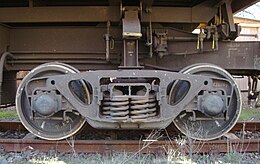
Back عربة محورية Arabic Вагонная каляска Byelorussian Талига Bulgarian বগি Bengali/Bangla Bogi Catalan Podvozek (železnice) Czech Bogie Danish Drehgestell German Boĝio Esperanto Bogie Spanish
This article needs additional citations for verification. (September 2022) |

| Part of a series on |
| Rail transport |
|---|
 |
|
|
| Infrastructure |
|
|
| Service and rolling stock |
|
| Urban rail transit |
|
|
| Miscellanea |
|
|
A bogie (/ˈboʊɡi/ BOH-ghee) (or truck in North American English) comprises two or more wheelsets (two wheels on an axle), in a frame, attached under a vehicle by a pivot. Bogies take various forms in various modes of transport. A bogie may remain normally attached (as on many railroad cars and semi-trailers) or be quickly detachable (as for a dolly in a road train or in railway bogie exchange). It may include suspension components within it (as most rail and trucking bogies do), or be solid and in turn be suspended (as are most bogies of tracked vehicles). It may be mounted on a swivel, as traditionally on a railway carriage or locomotive, additionally jointed and sprung (as in the landing gear of an airliner), or held in place by other means (centreless bogies).[citation needed]
Although bogie is the preferred spelling and first-listed variant in various dictionaries,[1][2][3] bogey and bogy are also used.[1][2]
- ^ a b Merriam-Webster, Merriam-Webster's Collegiate Dictionary, Merriam-Webster.
- ^ a b Houghton Mifflin Harcourt, American Heritage Dictionary of the English Language (5th ed.), Houghton Mifflin Harcourt, archived from the original on 14 July 2015, retrieved 24 November 2014.
- ^ Oxford Dictionaries Online, Oxford Dictionaries Online, Oxford University Press, archived from the original on 2 December 2014.